 I run StreamSets Data Collector on my MacBook Pro. In fact, I have about a dozen different versions installed – the latest, greatest 2.5.0.0, older versions, release candidates, and, of course, a development ‘master’ build that I hack on. Preparing for tonight’s St Louis Hadoop User Group Meetup, I downloaded Cloudera’s CDH 5.10 Quickstart VM so I could show our classic ‘Taxi Data Tutorial‘ and Drift Synchronization with Hadoop FS and Apache Hive. Spinning up the tutorial pipeline, I was surprised to see an error:
I run StreamSets Data Collector on my MacBook Pro. In fact, I have about a dozen different versions installed – the latest, greatest 2.5.0.0, older versions, release candidates, and, of course, a development ‘master’ build that I hack on. Preparing for tonight’s St Louis Hadoop User Group Meetup, I downloaded Cloudera’s CDH 5.10 Quickstart VM so I could show our classic ‘Taxi Data Tutorial‘ and Drift Synchronization with Hadoop FS and Apache Hive. Spinning up the tutorial pipeline, I was surprised to see an error: HADOOPFS_13 - Error while writing to HDFS: com.streamsets.pipeline.api.StageException: HADOOPFS_58 - Flush failed on file: '/sdc/taxi/_tmp_sdc-847321ce-0acb-4574-8d2c-ff63529f25b8_0' due to 'org.apache.hadoop.ipc.RemoteException(java.io.IOException): File /sdc/taxi/_tmp_sdc-847321ce-0acb-4574-8d2c-ff63529f25b8_0 could only be replicated to 0 nodes instead of minReplication (=1). There are 1 datanode(s) running and 1 node(s) are excluded in this operation. I’ll explain what this means, and how to resolve it, in this blog post.
 Graph databases represent and store data in terms of nodes, edges and properties, allowing quick, easy retrieval of complex hierarchical structures that may be difficult to model in traditional relational databases. Neo4j is an open source graph database widely deployed in the community; in this blog entry I’ll show you how to use StreamSets Data Collector to read case data from Salesforce and load it into the graph database using Neo4j’s JDBC driver.
Graph databases represent and store data in terms of nodes, edges and properties, allowing quick, easy retrieval of complex hierarchical structures that may be difficult to model in traditional relational databases. Neo4j is an open source graph database widely deployed in the community; in this blog entry I’ll show you how to use StreamSets Data Collector to read case data from Salesforce and load it into the graph database using Neo4j’s JDBC driver. The Script Evaluators in StreamSets Data Collector (SDC) allow you to manipulate data in pretty much any way you please. I’ve already written about
The Script Evaluators in StreamSets Data Collector (SDC) allow you to manipulate data in pretty much any way you please. I’ve already written about  I run StreamSets Data Collector on my MacBook Pro. In fact, I have about a dozen different versions installed – the latest, greatest 2.5.0.0, older versions, release candidates, and, of course, a development ‘master’ build that I hack on. Preparing for tonight’s
I run StreamSets Data Collector on my MacBook Pro. In fact, I have about a dozen different versions installed – the latest, greatest 2.5.0.0, older versions, release candidates, and, of course, a development ‘master’ build that I hack on. Preparing for tonight’s